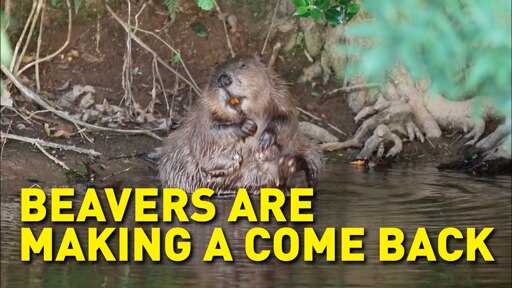Beavers, which were hunted to extinction in Britain in the 16th century, are making a comeback and in the process are helping to restore valuable wetland ecosystems. Known as nature’s engineers they restore wetland habitats through dam-building and felling trees, slowing, storing and filtering water in their habitat, which attracts other wildlife and reduces flooding downstream.
In the UK, 90% of wetland habitats have been lost over the last 100 hundred years. These waterlogged environments are rich in biodiversity and the loss has led to a drastic decline of wildlife. They are also important in countering the effects of extreme weather conditions, storing and absorbing the water flow during floods and storms.
Guy Henderson heads to Devon to see beavers flourishing in English rivers. Derek Gow, a key figure in rewilding beavers, shows the difference they have made to his land. As the former farm was being transformed, Gow also introduced a number of other lost British species, turning it into a biodiversity hotspot. Recent changes to legislation mean the beaver now has protected status in England as it does in Scotland and elsewhere in Europe.
 the animal proletariat
the animal proletariat
I’ve had this idea in mind for some time, but elephant-beavers , or castodonts as I like to call them in my mind, would be a terrifying concept. You know how an entire region had to be evacuated when lake Nasser was built? And something similar happened in china too? Well a pack-of castodonts would be able to build a similar-scale dam and block a major river, and they wouldn’t warn anyone ahead. Millions could drown.
I for one will supply wood and guns to the beaverpocalypse.
 I LOVE WETLANDS
I LOVE WETLANDSbeavers huh

I thought beavers were number 2, how do elephants change their environment?
Also fun fact the catholic church once decreed that beavers were fish so settlers in America could eat them during lent.
Elephants carve highways through their environment, litter them with water holes and fertiliser, transport edible plant seeds across those vast distances, and thin the forest canopy to promote new growth.
That’s awesome, not super familiar with them since they’re half a world away but I’ve encountered beavers imapact first hand while dragging boats over beaver dams.
Every time I go hiking in the Rockies it makes me a little more of a Beaver Marxist. The waterways are so diminished due to urban/agricultural usage below the mountains, and the landscape around them suffers in a multitude of ways from soil erosion to biodiversity loss to spawning chronic wasting disease because there isn’t enough healthy habitat up there after the fires our beaver eradication intensify. In the few areas where beaver ponds remain, the land is so healthy and lush.
Yea same on the east coast its wild how beneficial wetlands are to biodiversity and it’s even wilder that nothing humans have come up with is anywhere near as effective at creating wetlands as just letting beavers do their thing.
beavers are the superior Nijaraj
I found a YouTube link in your post. Here are links to the same video on alternative frontends that protect your privacy:
turning it into a biodiversity hotspot
So, fun fact! As someone who lives in a biodiversity hotspot (we have like half the world’s species of passerine birds iirc, among other things) that’s Not A Good Thing. The marketing is that a biodiversity hotspot is a place with a high level of biodiversity, but that’s only half of it. The other half is that the biodiversity is under significant threat - so for example, 90% of wetlands on the ~4m acre swan coastal plain, including among others some very rare, ecologically important peat bogs, have been lost to development, and that’s why I live in a hotspot instead of just a place with a high level of biodiversity.
yayyyyyy
sometimes I wonder why I bother with this whole enviro science thing, we ain’t fixing this shit. Humanity is going to keep on cooking til we boil the fucking oceans dry then get annoyed that we ran out of gas.
sometimes I wonder why I bother with this whole enviro science thing, we ain’t fixing this shit. Humanity is going to keep on cooking til we boil the fucking oceans dry then get annoyed that we ran out of gas.
The only way I survive horticulture is by repeating a Lenin quote like a mantra: “I am certainly not radical enough. One can never be radical enough; that is, one must always try to be as radical as reality itself”. We’re stuck on the vanguard of the climate collapse, but that background makes us uniquely equipped to become as radical as the reality of it and really purify the hate in peoples’ hearts.




